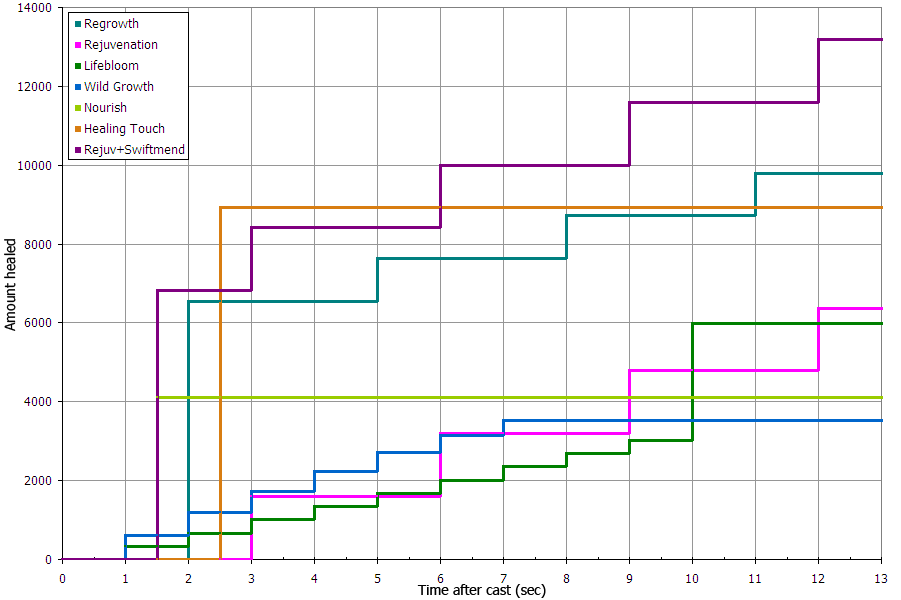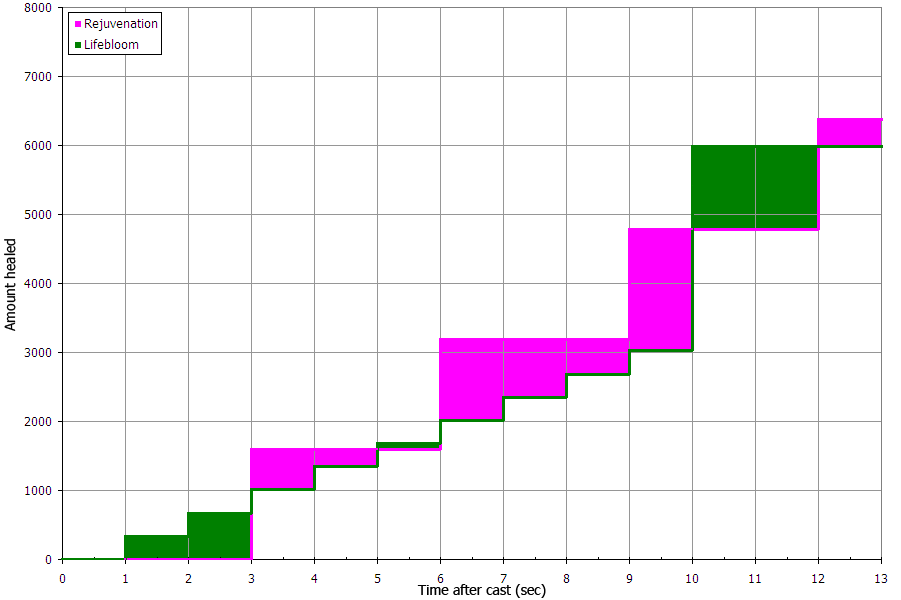I wrote a post last week with stat weights for both trees and Moonkin. Today I wanted to go into the qualitative reasoning behind the numbers.
Here were the weights I had for Resto:
Resto weights:
MP5: 10.0
Spellpower: 9.4
Intellect: 5.8
Spirit: 5.1
Haste: 2.9
Crit: 2.0
Socket-Red: 180.0
Socket-Yel: 130.0
Socket-Blue: 110.0
Socket-Meta: 320.0
I'll look at primary, secondary, and tertiary stats. I'll skip the gems today, but in essence they're based on looking at stat values for the best blue-quality gems of a given color.
Primary Stats: MP5 and Spellpower
It is just about impossible to overstate the importance of
Spellpower (SP). It is the fastest way to increase the size of your heals. This benefits you in all kinds of ways. Beyond having more powerful heals, you'll also have to cast
fewer heals, which will save your mana. Spellpower always has been and always will be a key stat for any caster class. There will never come a time when you say "No thanks, I've got enough."
Mana per 5 sec (MP5) provides the opposite side of the equation — more mana. Specifically, it boosts your mana recovery rate. This works on both sides of the
5 second rule (5SR), but its most important when you're casting.
The value of MP5 is much less clear-cut than Spellpower. If you're not running out of mana, you have either enough or too much MP5. As mana regen isn't really a problem for many players, you'll see statements that "MP5 is overvalued". If two items are otherwise similar, but one has MP5 while the other has more SP, most players will prefer the SP item.
When you're evaluating gear with MP5, consider whether you ever go OOM. Don't think about the easy stuff you do; think about when you're really working. (You want to gear for the most challenging situations, right?) If your mana bar is mostly full, give MP5 a lower weight. But don't drop it entirely; you never know when
new content will start drinking your mana again.
And also, be prepared for this to change; the developers have clearly stated that they want to look at mana regen. No info yet on whether this will be a tweaking of the numbers, or a complete change to the way the stats work.
Secondary stats: Intellect and Spirit
I only call these 'secondary stats' because they're weighted about half of SP and MP5. But Spirit and Intellect are important.
Intellect (Int) does a few related things for you:
- Increases your mana pool
- Improves your mana regeneration
- Increases your spell crit chance
Our main concerns are the mana implications. A bigger mana pool is helpful in a lot of ways. The 'mandatory' raid buff
Replenishment returns a percentage of your maximum mana, so a bigger pool works well with this.
Intellect is also key for Moonkin who have the
Lunar Guidance and
Dreamstate talents. But we're talking Resto here!
Spirit (Spi) is primarily about mana regen. By default it affects your MP5 only when you're out of the 5SR, but
Intensity allows 30% of that to carry over while you're casting too. Spirit directly affects this regen ability, but it's also modified by the
square root of Intellect. So Spirit has a much stronger effect on mana regen, but since Intellect also increase your mana
pool, it has overall the bigger impact.
Your regen outside the 5SR is also important because of
Innervate. Pure MP5 has no effect on Innervate; it's based completely on your Spirit-based regen. A common rule of thumb is that "you need enough spirit to regen a full mana bar within one Innervate." That's a good target but it's neither a firm requirement nor a hard cap on Spirit.
Spirit also affects your Spellpower via the
Improved Tree of Life talent. It's a 5/10/15% effect, so 100 Spi adds 15 SP if you have the talent maxed out.
So you'll want both Int and Spi. As it happens, Intellect is found on more pieces of gear, so you'll probably wind up with a good amount without trying. Spirit is less common, so keep an eye for items that have a good bit of spirit on them. If you're close to a 50/50 weight between the two, you're probably in good shape.
Tertiary Stats: Haste and Crit
In the abstract, these are good stats.
Crit rating increases your chance for a spell crit, while
Haste rating reduces cast times and reduces your
GCD. Both these stats used to have spell-specific versions, but in current WoW they are shared with their melee counterparts.
But both are a bit problematic for Resto druids, for various reasons.
Haste has two significant challenges. For one, our most important spells are instant cast, and see no direct benefit from haste. Regrowth, Nourish, and Healing Touch are all affected, but these are not really staples of the healing rotation.
On the other hand, the GCD reduction is nice. The problem here for Resto is
Gift of the Earthmother. It already reduces your GCD by 30%, so you have quite a head start.
That puts your GCD at 1.05s, but the GCD can't go below 1s. (
Edit: With patch 3.0.8, GotEM now reduces your GCD to a flat 1.2s max.) Phaelia did a
complete analysis of the relationship. But the upshot is that your GCD is already pretty fast, and so haste is OK but not crucial.
Crit suffers from the same problem: our best spells don't use it, and our talents make it a bit redundant. Our HoTs don't crit, which removes most of the value of crit right away. You won't cast Nourish or Healing Touch all that often, and you will mostly not let Lifebloom bloom, so you just won't get many crit chances from these spells.
The exception is Regrowth; that's used fairly frequently and crits are quite useful. But here we have
Improved Regrowth, giving Regrowth a 50% increased chance to crit. So here Crit is just going to have less impact. A change from 15% to 16% crit is a big improvement; you'll crit about 7% more frequently. But going from 55% to 56% is hardly noticeable — only a 2% increase in crit frequency.
Crit is still useful, mostly for your NS+HT combo and for when you want Lifebloom to expire. But, like haste, you'll never feel like it's a stat that you're actively trying to stack. My experience is that you'll have plenty of both without searching it out. Treat it as a tiebreaker between otherwise similar pieces of gear, with Haste just a bit more important than Crit.
Other stats
The other stats you will consider are defensive stats: armor, Stamina, and resilience. These are crucial for PvP, but for PvE instances they're generally not worth sweating over.
Stamina is probably the most important, as you're sure to take random damage at some point. But most gear carries Stamina anyway so you're not likely to go searching for it.
Armor only matters if you're getting whacked by something. So if all's going smoothly, it should be irrelevant. This is why you should feel OK about wearing some cloth gear, when it's available. (Don't take too many rolls from your priest, mage or warlock friends — they need gear too!) Resilience is even less important for PvE, but it will help a bit.
You will see some caster gear with
Hit rating on it. This does absolutely nothing for a healer, but you'll see some good caster gear with hit on it. This is designed for Moonkin (or Mages or Warlocks if it's cloth). Leave it for the DPS casters if they need it, but if not, the gear may still be useful to you despite the irrelevant hit rating.
Otherwise there really aren't any stats that a Resto druid will care about. Spellpower and MP5; Intellect and Spirit; Haste and Crit.

